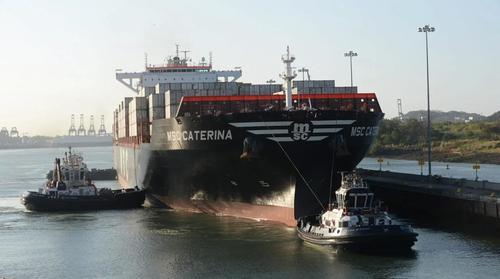Escape From LA: More Container Business Flees To East Coast
By Greg Miller of FreightWaves,
If so many container ships are stuck in the Pacific Ocean, waiting for weeks for a berth in Los Angeles or Long Beach, why not reschedule calls to another port? Why not make like Kurt Russell as Snake Plissken in the circa-1996 film and “Escape from LA”?

It’s not that simple, given how much warehousing and transloading capacity is built around the Southern California gateway — and congestion is affecting every port in America. Even so, shippers and carriers are indeed moving to sidestep Los Angeles/Long Beach.
In the ongoing battle for Asian imports between the West Coast and East Coast, the momentum is once again swinging back to the east. “November was the sixth straight month in a growing dichotomy in performance between the West Coast and East/Gulf Coast port ranges, with the latter performing markedly better,” wrote consultant John McCown in the new edition of the McCown Container Volume Observer.
Containerized imports to the top West Coast ports fell 7.5% year on year in November, he reported. In contrast, imports to East/Gulf Coast ports rose 9.9%.
McCown also tracked year-over-year changes in imports to West Coast versus East/Gulf Coast ports on a three-month trailing average basis. These numbers confirm a significant shift from the Pacific, reversing the switch in favor of the West Coast seen in the earlier months of the pandemic.
‘Anywhere but LA’
American Shipper asked consultant Jon Monroe about the potential to switch ports and avert Los Angeles/Long Beach congestion.
“It’s happening already,” said Monroe during a recent video interview. “I can’t name specific companies, but I can tell you a company that’s got huge facilities on the West Coast that normally calls LA/LB has moved to Houston and set up a transload center there.
“There are a lot of people saying, ‘Anywhere but LA’ — and yet you still see this long line of vessels coming in that are offloading in LA.
“You’re seeing the East [and Gulf] Coast being more of an opportunity,” said Monroe. “Let’s face it, many of these big importers can deliver from anywhere because they have a national network, whether it’s Los Angeles or Charleston or Norfolk or Jacksonville or Houston.
“I think a lot of people will adjust their network and are looking at their negotiations and trying to put more of their facilities or more of their containers outside of where they normally go in Southern California.”
Carriers are making moves as well as shippers. One example: Mediterranean Shipping Company’s Santana service previously sailed from Asia to Tacoma. In November, MSC switched the service to the East Coast: from Asia to Charleston and New York via the Panama Canal. The Santana service will add a Houston call starting next month.
East Coast vs West Coast
Pre-pandemic, imports from Asia were trending toward the East Coast. One driver was the West Coast labor dispute in 2014-15, which prompted importers to diversify their networks. Another was the expansion of the Panama Canal in 2016, allowing much larger container ships to call at Atlantic and Gulf ports. Complementing those two drivers was the fact that most of the U.S. population lives in Eastern states.
During a 2020 interview with American Shipper, Deutsche Bank transportation analyst Amit Mehrotra maintained that the pull of the East Coast was a secular trend. “Keep in mind that 60% of the population lives east of the Mississippi,” he explained. “At the end of the day, if you come into the West Coast, you’re going to have to rail a lot of it east, to where the demand centers are.
“With the expansion of the Panama Canal and the port projects on the East Coast that allow for bigger ships, and with the majority of the population in these states, it disproportionately favors the East Coast ports.”
That secular trend was interrupted by COVID, which flipped the balance of power back to the west.
Passenger planes were grounded, slashing air cargo capacity. Air freight rates spiked at the very time locked-in Americans accelerated their use of e-commerce. Importers needed goods faster to accommodate surging consumer demand. Some that had previously used air shifted to premium, high-speed trans-Pacific ocean service. Others that had previously favored the East Coast switched to LA/LB to save two weeks in transit time.
Now, the West Coast’s transit-time advantage has largely evaporated, offset by multi-week waits for berths. According to the Marine Exchange of Southern California, there were 94 container ships waiting for LA/LB berths as of Thursday. Thirteen of those ships had been waiting for a month or more. The vessel Wan Hei 516 had been waiting for more than two months, since Oct. 14.
According to new data from Shifl, average transit time from China to New York is now actually lower than from China to Los Angeles.
Advantage East Coast, yet again.
According to McCown, “The loads they are switching are destined for eastern points and the widely reported congestion at West Coast ports has made the additional time and uncertainty of intermodal moves across the country less attractive.
“Those decisions are made easier by the fact that linehaul transportation costs of moving containers to most eastern points are typically much lower with all or more vessel service to the East/Gulf Coasts compared to rail cross-country intermodal service via the West Coast.”
Tyler Durden
Wed, 12/22/2021 – 15:40
Zero Hedge’s mission is to widen the scope of financial, economic and political information available to the professional investing public, to skeptically examine and, where necessary, attack the flaccid institution that financial journalism has become, to liberate oppressed knowledge, to provide analysis uninhibited by political constraint and to facilitate information’s unending quest for freedom. Visit https://www.zerohedge.com

